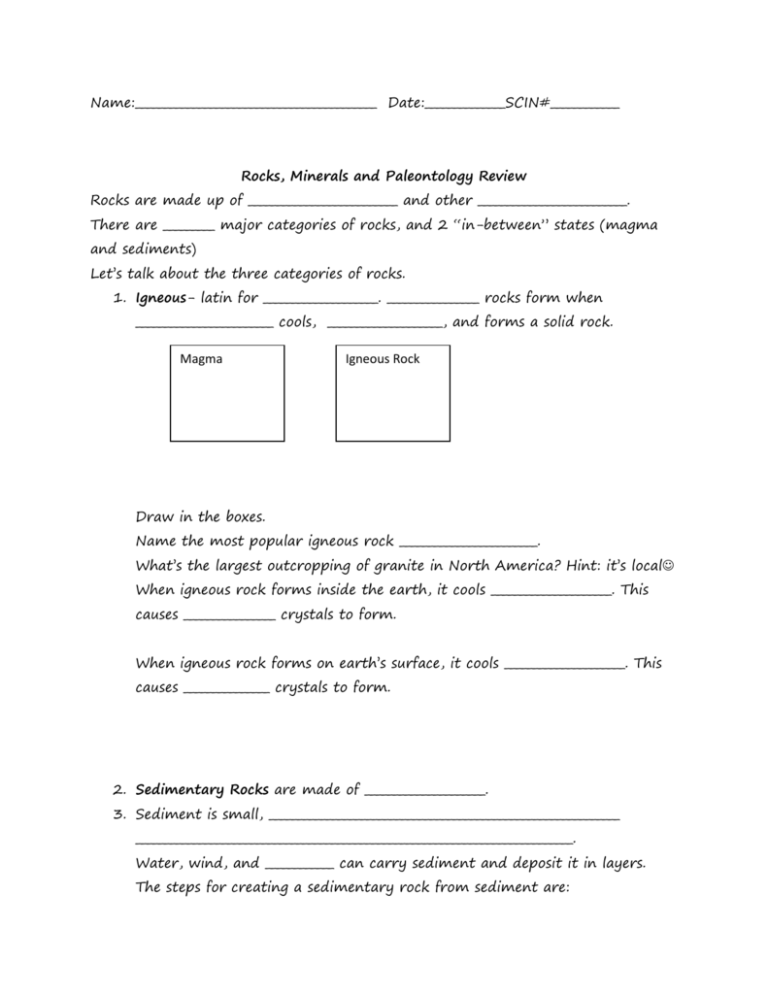Rocks and Paleo study guide no answers
advertisement

Name:__________________________________________ Date:______________SCIN#____________ Rocks, Minerals and Paleontology Review Rocks are made up of __________________________ and other __________________________. There are _________ major categories of rocks, and 2 “in-between” states (magma and sediments) Let’s talk about the three categories of rocks. 1. Igneous- latin for ____________________. ________________ rocks form when ________________________ cools, ____________________, and forms a solid rock. Magma Igneous Rock Draw in the boxes. Name the most popular igneous rock ________________________. What’s the largest outcropping of granite in North America? Hint: it’s local When igneous rock forms inside the earth, it cools _____________________. This causes ________________ crystals to form. When igneous rock forms on earth’s surface, it cools _____________________. This causes _______________ crystals to form. 2. Sedimentary Rocks are made of _____________________. 3. Sediment is small, _____________________________________________________________ ____________________________________________________________________________. Water, wind, and ____________ can carry sediment and deposit it in layers. The steps for creating a sedimentary rock from sediment are: 1. Erosion- ___________________________________________________________________________ 2. Deposition- ________________________________________________________________________ 3. Compaction- _______________________________________________________________________ 4. Cementation - _____________________________________________________________________ Draw your own version of sedimentary rock formation here. There are 3 types of sedimentary rocks. List and give an example of each. A. Clastic: ______________________________________________________________________ _____________________________________ ex: B. _________________________-forms where the remains of plants and animals are deposited in thick layers Ex: C. Chemical ______________________________________________________ ________________________________________________________________ Ex: 4. Metamorphic Rocks Meta means ______________________ and morphosis means ________________________. _____________________ and _______________________ deep beneath earth’s surface can change any rock into metamorphic rock. When I see the words _____________________ and _______________________ I automatically think: METAMORPHIC ROCK!!!! When a rock changes into metamorphic rock, its appearance, texture, crystal structure, and mineral composition change. Geologists classify metamorphic rocks by ___________________________________________ _____________________________________________________________________________ What is a foliated rock? _______________________________________________________________ _________________________________________________________________________________ The Rock Cycle Forces inside Earth and at the surface ____________________________________________________ ____________________________________________________________________________________ Finish the diagram. Use page. 95 if you need some help. Use these terms: heat and pressure, erosion, cooling and hardening, melting and draw arrows to indicate the direction. One has been done for you. Erosion Igneous Rock Sedimentary Rock Molten Material Metamorphic Rock (Magma) Melting Scientists who study fossils are ____________________________. (pg. 286) Fossils are ______________________________________________________________________________________________________ ____________________________________________________________________ They are found in ______________________ rock because the heat and pressure of a metamorphic rock or the melting of igneous rock would ______________________ them. Most fossils are found when living things are buried by sediment. The sediment ______________________________________________________________________________________________________ ____________________________________________________________________ Most fossils form from animals or plants that once lived in or near quiet water such as __________________, lakes, or ________________ seas where sediments build up. Fossils found in rock include petrified fossils, molds and casts, carbon films, and trace fossils or when the remains of organisms are preserved in substances such as tar, amber or ice. Preserved remains are found with little or no change, even sometimes preserving an entire large organism like a wooly mammoth. The La Brea tar pits in Los Angeles, California have preserved many fossils. Thousands of years ago, animals came to ____________________________________ the water and became _____________________ in the tar and then died. The tar soaked into __________________________________, preserving the bones from decay. Amber is ______________________________________________________________. There are two ways to determine the age of fossils. Their ________________________ age is their age compared to the ages of other rocks. What’s your relative age? _____________________________________________________________________________ The absolute age is the _____________________________________________________________________ ________________________________________________________________________. Tell your absolute age______________. The law of superposition states ________________________________________________________ Label the layers of rock from youngest to oldest. There are exceptions to every rule!!! (except class rules ) Faults are ______________________________________. A fault is an exception to the law of superposition because faults are ______________________ than the rock they run through. Intrusions are another exception to the law of _________________________ because the intrusion is also always _____________________________ than the rock around it. An index fossil is useful because they tell the _______________________________________ or the rock layers in which they occur. We use the ______________________________________________ to divide up earths history because it is so great! Who can even imagine millions or billions of years!!!! The geologic time scale is ___________________________________________________________________ _____________________________________________________________________________________ In your own words: Why do you think that we even care about fossils? Describe the importance of studying the age of rocks and minerals and fossils. Use the boxes below to divide the geologic time into usable parts. Precambrian Time Use these terms to complete the box. Precambrian time, Paleozoic, Mesozoic and Cenozoic Eras Include the organisms present. Reptiles, mammals, invertebrates, Describe in your own words: Paleontologists have learned a great deal from the study of fossils. What have they learned about the difference between the organisms from Precambrian time all the way through the Cenozoic Era?








